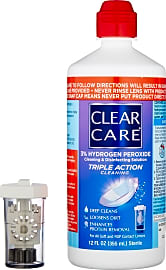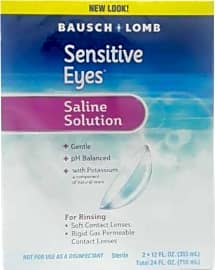The 10 Best Contact Solutions

This wiki has been updated 33 times since it was first published in February of 2017. If you wear contacts, you already know the importance of cleaning and storing your lenses in a fluid that'll keep your eyes moisturized without causing irritation. Here we've chosen our favorite contact solutions for cleaning, disinfecting, or storing, and some that can do all three. Note that it's important you follow the included instructions, because some chemicals can be harmful if misused. When users buy our independently chosen editorial recommendations, we may earn commissions to help fund the Wiki.
Editor's Notes
November 06, 2020:
You'll still find a range of both saline and multipurpose/disinfecting solutions here, but please keep in mind that only the latter were designed to actually clean your lenses. Plain saline solution can help with rinsing and storage, but it will not kill the nasty little germs that cause infection.
When it comes to the choice best able to tackle such bacteria, many users and doctors prefer Alcon Clear Care, which employs hydrogen peroxide to get the job done. You absolutely must follow all usage instructions — and note that some users experience discomfort, even when the solution is used properly. Because eye irritation seems to be less common with this "regular" Clear Care, we've retained it over the Plus version with HydraGlyde, which seems more likely to cause problems.
If you'd prefer to skip the hydrogen peroxide, then Opti-Free Puremoist, Biotrue Multi-Purpose, and Bausch & Lomb Renu remain great choices. These are popular, easy to use formulas for both disinfecting and storage. For a budget-friendly option, we added Equate Sterile, which tends to be less pricey than all of the former.
As for saline solution, PuriLens Plus Preservative Free is a go-to for many. True to its name, it has no preservatives, which also means it has a shorter shelf life than most; you should plan to discard it within two weeks of opening the bottle. The bottles are relatively small at only 4 ounces, however, so getting through one of them isn't too tall of an order. Plus, unlike some huge bottles, these should fit neatly in a toiletry organizer, although they're too big to make it past the TSA in your carry on.
August 09, 2019:
On this update, we've been happy to see that all of the options we chose to put on our previous ranking have stood the test of time. We've changed very little since the last go, but the most notable adjustment we've made is in moving Alcon's Clear Care formula up to the top spot. This formulation is one of the most frequently recommended by ophthalmologists, and it's a good value, too. With that said, we must note that it's important to follow the instructions carefully with this one. You have to let your lenses soak for a minimum of 6 hours — although longer is better — to give the peroxide enough time to be fully neutralized. Also, a fresh lens case is included with each package, so be sure to dispose of your previous case and use a fresh one upon opening each package.
Carefully following the included directions applies to all the items on our list, of course. The chemicals contained in contact solutions can irritate — and potentially harm — your eyes if not used correctly. If you're unsure of exactly what steps you need to take to ensure you're using your solution properly, you should consult your ophthalmologist.
October 19, 2018:
Moved PuriLens Plus Preservative Free down because it must be used within 15 days of opening. Added Bausch + Lomb ReNu and Equate Saline Sensitive due to their high quality and budget-friendly pricing and expanded offerings to include more options for rigid gas permeable lens users.
Special Honors
Dailies Disposables If you're tired of having to deal with contact lens solutions at all, you could opt for Dailies, which, as the name suggests, are disposable. Aside from convenience, these are more hygienic than traditional contact lenses. Those with sensitive eyes will likely benefit from these, too, as there won't be any potentially irritating chemicals involved. dailes.com
A Brief History of Contact Lenses
Learning about some medieval scholar trying to shove small wooden disks into his eyes would just give you the creeps.
Contact lenses are one of those things that, if a version of them existed before 1950 C.E. or so, you probably wouldn't want to know about it. Learning about some medieval scholar trying to shove small wooden disks into his eyes would just give you the creeps.
Despite any misgivings we may have, the idea for contacts dates all the way back to (who else?) Leonardo da Vinci. In 1508 C.E., the great inventor had an idea: he believed that submerging the head in water could alter vision.
He then devised a funnel with a glass lens, kind of like an aquatic monocle. Unfortunately, it wasn't terribly effective. However, about a century later, French philosopher René Descartes learned of da Vinci's idea and thought of an alternative. Descartes's idea was to put the glass tube in direct contact with the cornea.
The good news about this apparatus was, it kind of improved vision! Bad news was it made blinking impossible. You win some, you lose some.
Thomas Young, a British scientist, took the idea one step further in 1801. He reduced the size to a quarter of an inch, and then he glued it to his eyeball. Never let anyone tell you that Thomas Young wasn't dedicated to his research.
Unfortunately for Mr. Young, it didn't work.
Another Brit, Sir John Herschel, felt that creating something that molded tightly to the cornea was key. Unfortunately, it wasn't technologically feasible to do this yet, and the cowardly Herschel wasn't willing to just start gluing things to his eyeballs.
It would be a German ophthalmologist with the wonderful name of Adolf Gaston Eugen Fick that finally cracked the code. In 1888, he made heavy glass lenses that kept a solution between the cornea and the glass, which corrected myopia, but they could only be worn for a few hours at a time.
In 1949, corneal lenses were made. These were small and could be worn for most of the day, but the biggest issue with these models was that they didn't allow oxygen to pass through to the cornea, which could lead to health problems. Starting in the 1970s, however, gas-permeable models hit the scene, and wearing contacts became much safer and more comfortable, especially when soft contacts came along.
Since then, contacts have become smaller, thinner, less expensive, and capable of being worn all day long. They're ubiquitous as well, replacing glasses for many users — although LASIK surgery has been cutting into their market share in recent years.
One thing hasn't changed, however: people still look at you funny if you walk around with glass funnels glued to your eyes.
The Importance of Using a Quality Solution
You've likely already been lectured on the importance of using contact solution every night. Then again, you've also probably been lectured on the importance of flossing, eating plenty of vegetables, and not pirating Major League Baseball games, but those admonishments have probably fallen on deaf ears, too.
You really should listen to the contact solution lecture, though.
There are millions of tiny little microorganisms on your contact lenses, and if you don't thin the herd periodically, the nasty ones could overrun the others.
Don't think you can use just any liquid to clean them off, either.
That could lead to eye infections down the road. Conditions like keratitis, conjunctivitis, and other infections can result from wearing dirty contact lenses, and none of those conditions are fun or attractive.
Don't think you can use just any liquid to clean them off, either. Tap water is also full of contaminants that aren't suitable for putting in your eyes. And please — no saliva. You might as well just grab a fistful of garbage and rub it into your eyes if you're going to spit on your contacts.
Most solutions contain something that's slightly abrasive, helping them to gently slough off anything attached to the lens. They also have a mild detergent to clean them off, some include enzymes designed to take care of any protein films covering the contacts. Boric acid or hydrogen peroxide is included to take care of bacteria and fungi, and then ascorbic acid is dumped in to keep the whole solution sterile.
Always check with your eye doctor, or at least read the instructions on the box, before using a new solution. Because they don't all have the same active ingredients, they're not one-size-fits-all, and if you use one that's not suitable for your contacts, it can damage them.
The good news is, taking care of your contacts is remarkably easy, so as long as you're diligent, you shouldn't have any issues.
Until you get one stuck in your eye, that is. That's the worst.
How to Properly Care for Contacts
When you first got your contacts, the doctor likely told you exactly how to care for them.
But you weren't listening, were you?
That's OK — nobody does, except us. We'll fill you in on what you missed.
Once you're done, insert it in your eye if you're putting it on, or in a case filled with clean solution if you're taking it off.
The most important thing is not to wear them longer than you should. No matter how meticulous you are about taking care of them, wearing them too long will increase the risk of infection or buildup on the lens. Do what the manufacturer recommends.
As for cleaning, start off by washing your hands thoroughly. Dry them with a lint-free towel or a few paper towels. Don't use lotion or anything like that beforehand (and definitely don't chop jalapeños).
Spray the lenses down thoroughly with solution, one at a time. Then, rub it gently with your finger to loosen up debris. Once you're done, insert it in your eye if you're putting it on, or in a case filled with clean solution if you're taking it off. Then, repeat for the other lens.
Do this every time you handle your lenses. Not only will it keep your eyes clean and hygienic, it can help prolong the life of your lenses, which is good, because those suckers are expensive.















